Stunningly golden-brown and crusty on the outside, while soft and studded with sweet roasted garlic on the inside, this No-Knead Bread is incredibly easy to make and simply delicious! Each fluffy, flavorful slice is smothered with a creamy, bright Homemade Basil Butter.
This post may contain affiliate links. Read our disclosure policy.
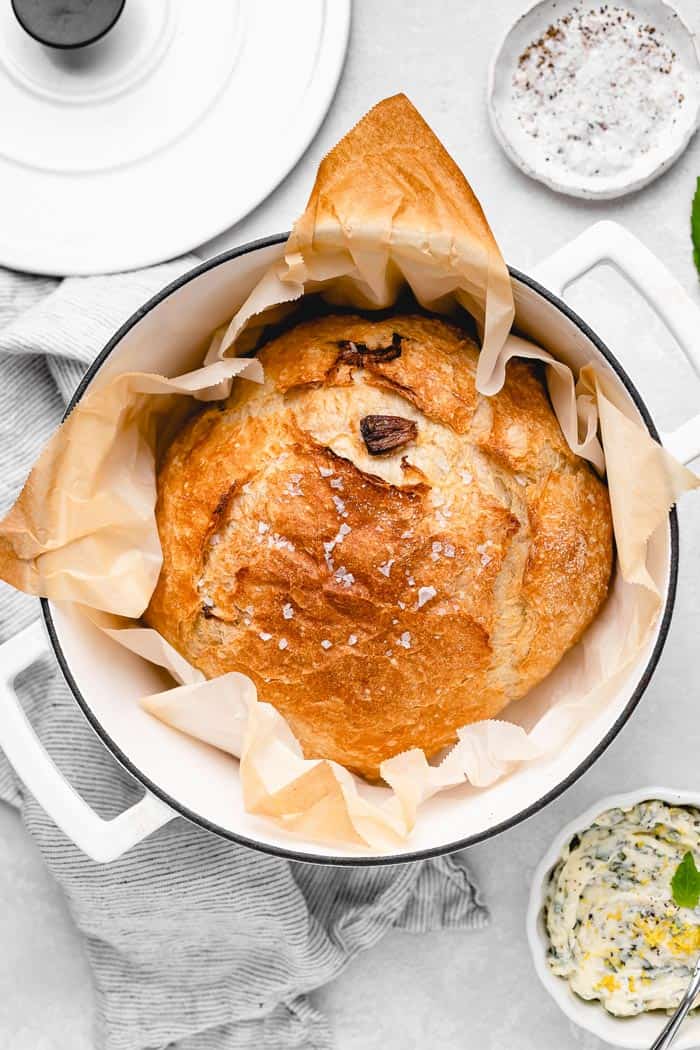
Hey it’s Leidi again! In another life, or maybe later in this one, I’d like to be a bread baker. I’d spend my days kneading dough, humming to myself to fill the silence. Pulsing veins will run through my forearms and my hands will learn to crave that subtle ache. The dough will speak to me, communicating via texture and sound. The crusty loaves I sling will sigh as I slice, each cut revealing pillowy bread riddled with air pockets.
The best part of my imaginary craft? Breaking bread with others. I’d invite just about anybody to sit at my table; they’d share stories in exchange for buttered, sandwiched, or grilled slices. You’d be surprised at how something as simple as bread can even the playing field.
But alas, I’m just not there yet, and I’m not sure when I will be. Bread baking isn’t easy; it requires an incredible amount of patience and intuition. There’s a science to the practice that can be taught, but it doesn’t hurt to have a bit of raw talent too. Some folks just have the stuff, you know?
So, until I’m reborn as Nancy Silverton of LaBrea Bakery or Chad Robertson of Tartine, I’ll just have to make due with the stuff I got. Today’s No-Knead Roasted Garlic is a foolproof recipe for those of us who crave fresh bread but don’t want to sacrifice massive amounts of time or energy to make it. Fragrant, sweet, savory, crunchy-on-the-outisde, soft-on-the-inside, and delicious beyond belief, this loaf is one you’ll come back to.
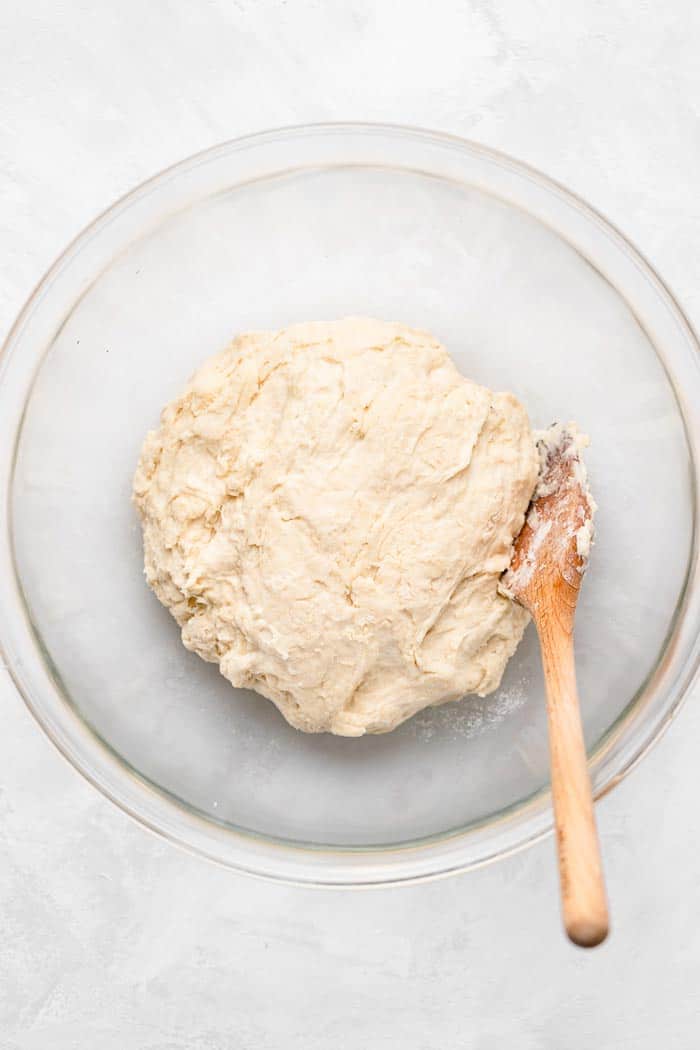
Ingredients
This recipe is simple; there isn’t a long list of ingredients and not much active baking is required. When a recipe is this easy, the quality of your ingredients becomes that much more vital.
Here’s what you need to know about what we’re using today:
- All-Purpose Flour– Bread baking HEAVILY relies on the quality and texture of flour. For this recipe, I chose to use Organic Great River Lily White All-Purpose Flour: a premium bread flour from a blend of carefully selected wheat. I find that a higher quality flour produces a more tender, moist bread. But, I have also made this recipe using everyday AP Flour (like King Arthur or Gold Medal) and still achieved a delicious result.
- Kosher Salt– I keep copious amounts of kosher salt on hand at all times; it’s reliable and inexpensive.
- Active Dry Yeast– If your yeast has been sitting in the pantry (or fridge) for longer than you can remember, it might be time to replace it. Yeast does indeed have an expiration date and, if used beyond that date, it can impart rancid taste or make for a failed rise.
TIP: Proof your yeast to find out if it’s still active by adding 1 teaspoon of sugar and 2 1/4 teaspoons of yeast (one envelope) to 1/4 cup of warm water. Then, wait 10 minutes. If the mixture bubbles and develops a yeasty aroma, the yeast is still good.
- Warm Water– If the water is too hot, it will kill the yeast but, if the water is too cold, it won’t rise. The water should be between 100-110 degrees. If you don’t have a thermometer, use your wrist to test the water temperature. If it feels very warm on your wrist, it’s perfect for the yeast.
- Garlic– Garlic takes on its best form when roasted. As it cooks, garlic slowly caramelizes and develops a sweetness. The aroma is unbelievable, and it’s flavor is unmatched. After the bread has baked, you’ll find cloves flecked throughout, and biting into one is an experience you won’t forget.
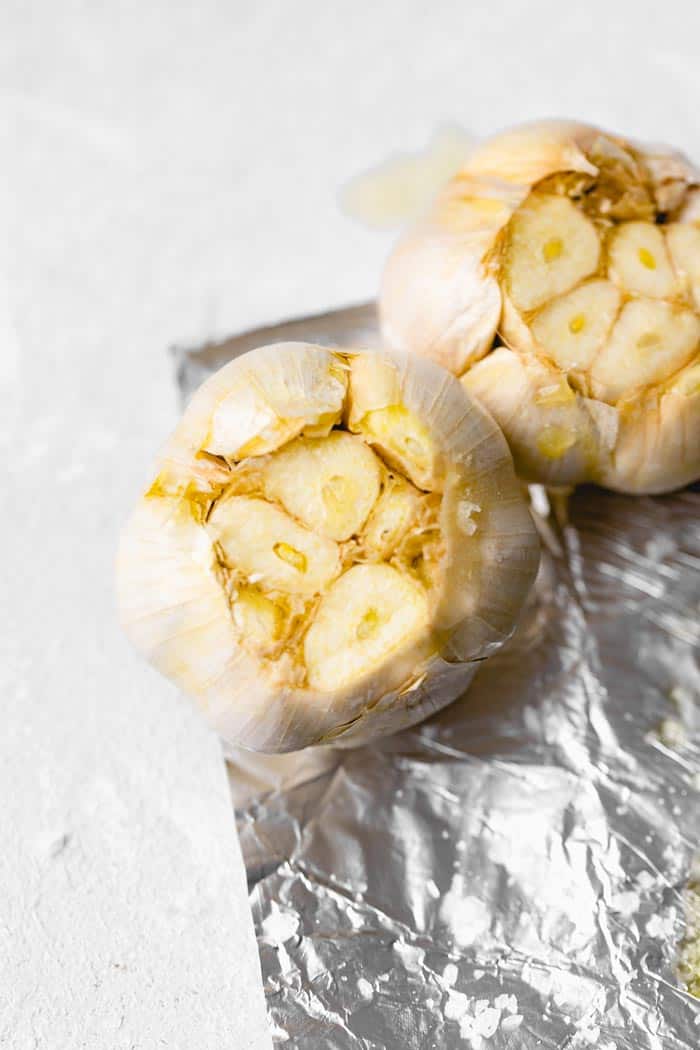
TIP: If you’re not a huge garlic fan, that’s ok! Feel free to cut back on the measurement or omit completely. This ingredient can be replaced with fresh herbs, seeds, or dried fruit.
- Olive Oil– I can drink olive oil by the glass full. Buttery, floral, smooth, and aromatic, there’s little that olive oil can’t make better. Coating the dough in oil helps the outside crisp during baking, making for a gorgeous golden-brown color too.
- Maldon Flaky Sea Salt– If you don’t own flaky salt, it’s time to get some. Sprinkling a bit of crunchy, chunky salt adds texture and enhances flavor. Add as much or as little as you’d like! Fresh cracked pepper is also a great addition.
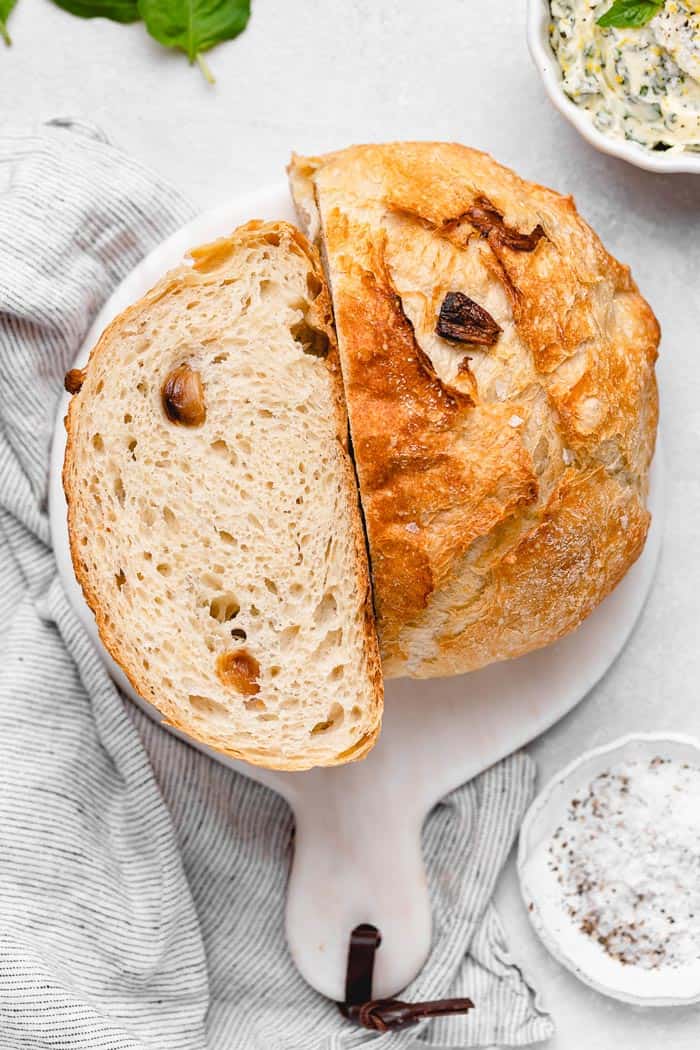
Want to Save This Recipe, Boo?
How to Make No-Knead Bread
There are just 5 simple steps to this recipe! Don’t overthink it, don’t rush it, and don’t forget to have fun making it.
- Roast the Garlic – Before measuring any flour or digging through the cupboards for a spare packet of yeast, you’ve gotta roast the garlic. Be sure to tightly wrap the bulbs in foil and, when they’re done, allow them to completely cool before handling. Use a fork to carefully remove each clove from their papery pockets.
- Make the Dough – As promised, this is a no-knead dough, which means it requires very minimal amount of effort. Just mix the wet and dry ingredients until they form a shaggy dough, then cover and wait.
- Play the Waiting Game – Don’t try to rush the rise! As the dough slowly rises, it develops flavor and texture. This dough needs to rise for at least 6-8 hours in a room temperature spot.
- Second Rise – Once the dough has risen, and you’ve gently folded in the roasted garlic, it’s time for a second rise. I recommend allocating an hour for the second rise, then preheating both the oven and the Dutch oven, together.
- Bake, Cool, + Serve – Quickly and carefully transfer your dough into the Dutch oven, then drizzle with olive oil and sprinkle with salt. Do not disturb the bread as it bakes! You’ll be able to keep a closer eye once the lid is off. Wait to slice until the bread has cooled, otherwise you’ll let out all the moisture.
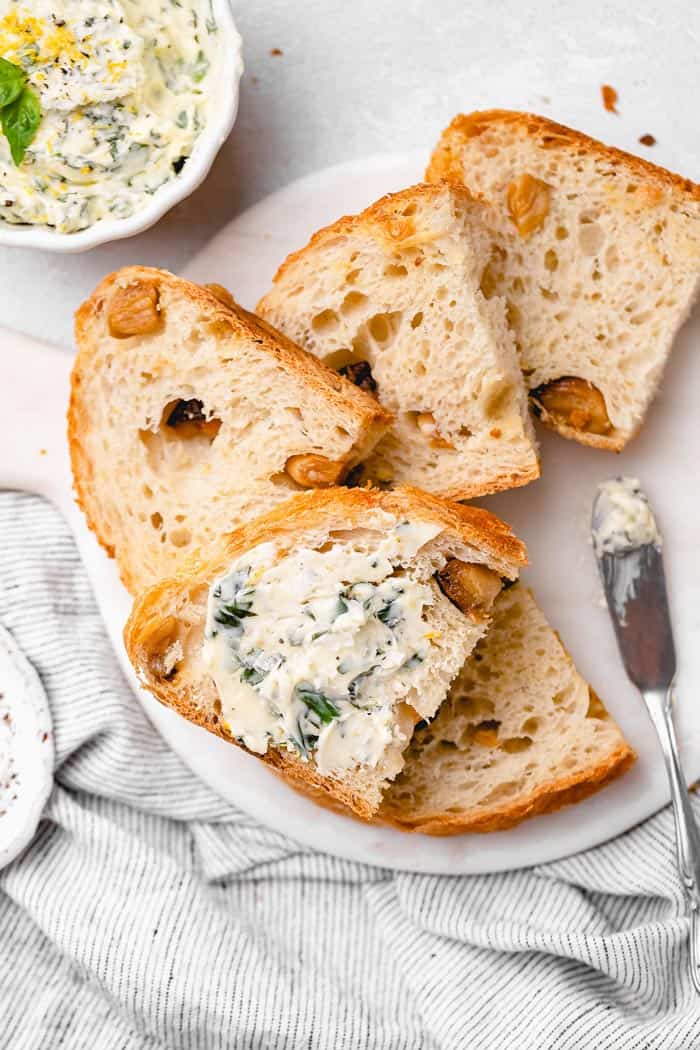
How Long Does Homemade Bread Keep For?
I’ve made this no-knead bread about half a dozen times or so, and each time it didn’t last longer than 20 minutes. I’m starting to think this might just need to be a double-batch kind of recipe!
In the case that you do have leftover bread (lucky you), wrap it tightly in plastic or beeswax wrap, then store in a room temperature spot for up to 3 days.
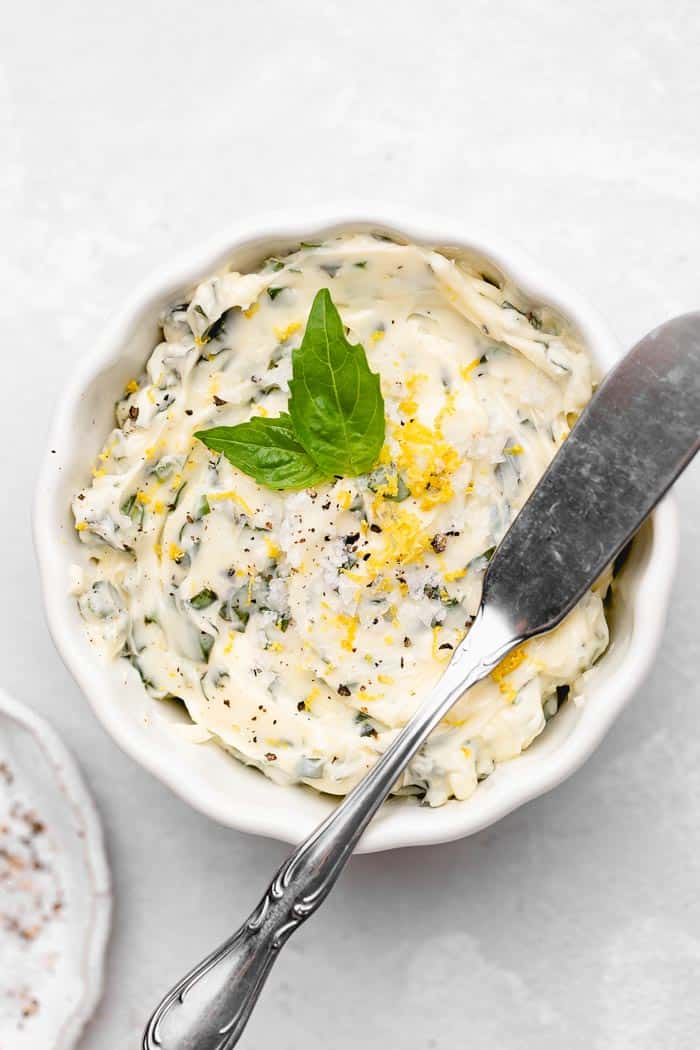
Basil Butter Ingredients
Fresh bread is made that much more decadent by being slathered in herby, bright butter. When spread on a slice of warm bread, basil butter melts and mingles to create a complex bite.
- Salted Butter – You’ll come to know that I like things on the saltier side, so salted butter is a must here. Unsalted will work too, just be sure that the butter is at room temperature, and mailable, either way.
- Basil – Fresh basil should be fragrant, sweet, and almost citrusy. Feel free to use as much or as little as you’d like! Rosemary, thyme, and oregano can also be used.
- Salt + Pepper – Go on, taste the butter and season as needed. Relying on your own taste and preferences is important to any recipe.
Lemon or Orange Zest (optional)- When I’m feeling extra zippy, I like to add a dash of citrus to my butter. The added tangy bite cuts through the fat and lightens everything up.
TIP: Make the butter as the bread bakes, then refrigerate as the bread cools. The texture should be firm but still easily spreadable.
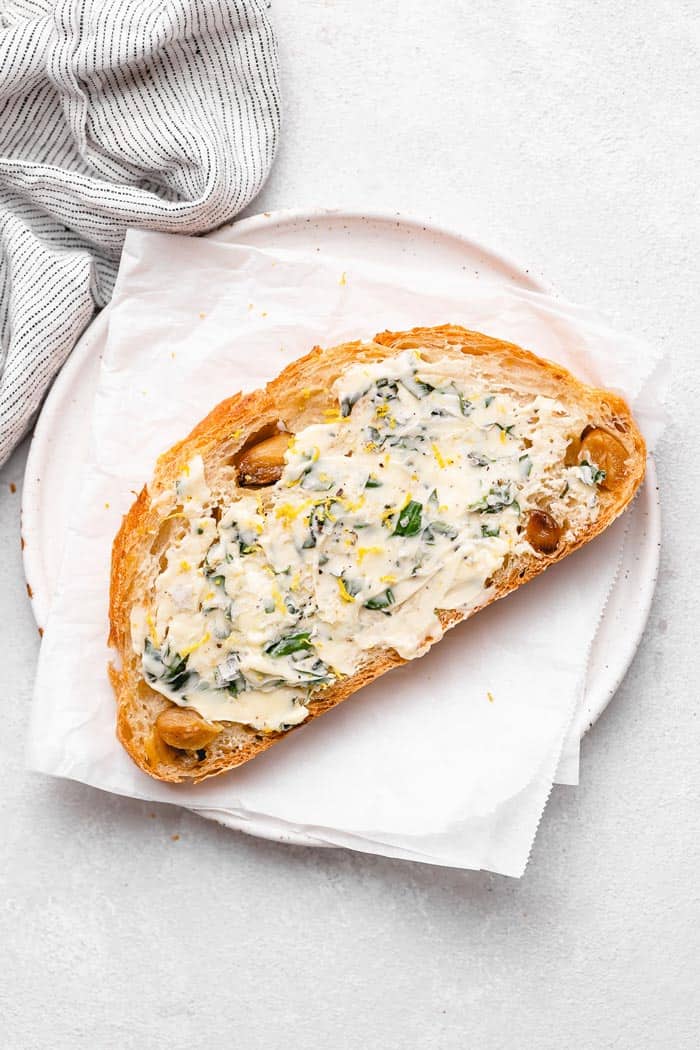
Storage
Herb Butters can be stored in the refrigerator for several days, preferably in a sealed container (the parchment paper roll may be sealed in a plastic zipper top bag).
Favorite Bread Recipes
If you love this, you will also love this Garlic Bread, Banana Bread, Garlic Cheese Rolls and Dinner Rolls recipes.
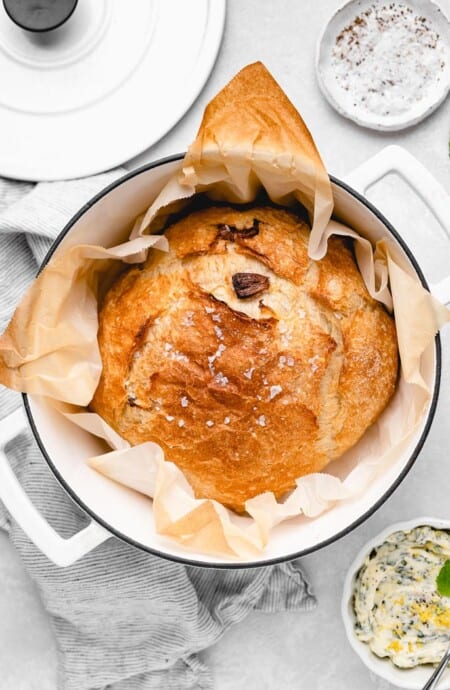
Roasted Garlic No Knead Bread with Basil Butter
Want to Save This Recipe, Boo?
Ingredients
For the Yeast Mixture
- 2 1/4 tsp active dry yeast
- 1 tsp granulated sugar
- 1/4 cup warm water
For the Roasted Garlic Bread
- 3 cups all purpose flour
- 2 tsp kosher salt
- 1 1/4 cup warm water
- 2 garlic heads
- 3 tbsp olive oil
- 2 tsp flaky sea salt I used Maldon
For the Basil Butter
- 1/2 cup salted butter room temperature
- 1/2 cup fresh basil chopped
- 1/2 tsp lemon or orange zest optional
- kosher salt and fresh cracked black pepper
Instructions
For the Roasted Garlic Bread
- In a small bowl, combine active dry yeast, sugar, and ¼ cup warm water. Stir together until sugar and yeast have dissolved. Let sit until foamy and bubbly, about 5-6 minutes.
- In a large bowl, whisk together flour, salt, yeast mixture and 1 ¼ cup warm water until a shaggy dough forms. Cover the bowl with a dish towel and set in a warm place and allow to rest until doubled in size, about 3 hours.
- While dough rests, roast the garlic. Preheat the oven to 400F. Rub off excess layers of papery skin from each garlic head, and slice off top 1 inch to expose the cloves. Place each head on a small square of foil, then divide and drizzle 1 tablespoon of oil over top of each garlic head. Wrap the garlic tightly in the foil and bake until fragrant and tender, about 45 minutes. Remove from oven and allow to cool completely.
- Once cool, carefully squeeze the bottom of each garlic head to remove each clove from their individual pockets. Place in a small bowl and set aside.
- Flour a clean surface, turn out dough, and gently punch it down. Push each clove into the bread, making sure to space them out. Fold over the dough until the garlic has fully incorporated and the dough is smooth, about 4-6 times. Sprinkle on extra flour as needed. Place the dough onto a sheet of parchment, place a clean bowl, cover with a dish cloth, and allow to rise again for about 1 hour, or until doubled in size again.
- Place a large Dutch oven in the oven (with racks arranged in the middle, then preheat to 450F. Once preheated, remove the pot from the oven and using the parchment paper as a sling, carefully transfer dough into the pot. Quickly drizzle remaining tablespoon of olive oil, sprinkle with flaky sea salt, then replace the lid.
- Place Dutch oven back into oven and bake for 30 minutes, without removing the lid. Uncover and bake for an additional 10-12 minutes, until the top is crusty and golden brown.
- Remove from the oven and transfer bread to a cooling rack. Wait for at least 20 minutes before slicing and serving.
For the Basil Butter
- In a small bowl, combine butter, basil, and zest. Use a fork to mash/combine the ingredients. Season with salt and pepper.
- Use parchment paper to tightly roll the butter in a log or cover the bowl with plastic wrap. Refrigerate until serving with bread.
I have no words!!! This is my go to for roasted garlic bread now!!!
Yay!! So happy you liked it!
Please add when to incorporate the yeast mixture. It’s completely missing. Hopefully I did it right.
Sorry about that! It’s when you mix all the things together.
The instructions say to mix in 1 1/4 cup warm water. Does that include the 1/4 cup of the yeast mixture or in addition to?
The 1 1/4 cups is for the bread dough, so in addition.
Amazing! A family favorite now!
This looks so good! What a great combination of flavors!